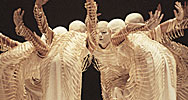 A Slight Error in Eros
A Slight Error in Eros
San Francisco Ballet’s Sylvia
Saturday, April 22, 2006, 8PM Last year when I heard that Mark Morris’
Sylvia wouldn’t be presented during San Francisco Ballet’s 2004-2005 Season, I was bummed. Was it the orgy in the woods, the confusion of nymphs with potential nymphos, or the drunken topless slaves that did
Sylvia” in? After 30 seconds of debate, I came up empty and moved on with life as I knew it. But luckily a year later, SF Ballet decided to bring the shirtless minions and story of female empowerment back to the stage.
I enjoyed
Sylvia the first time I saw it. With Megan Low as a charismatic and youthful Sylvia, she easily convinced everyone to root for her, and had we been at a baseball game, there would have been foot stomping, drum beats, and the wave. Morris’ version spotlighted the story; it served as the primary focus, with the choreography more about imagery and ideas as opposed to superfluous sautés and promenades. (The choreography itself seems much debated, with several saying that Morris’ ballet knowledge is flimsy at best, but I disagree. Maybe they haven’t seen
A Garden,
Sandpaper Ballet, or
Later, but trust me, Morris knows ballet, and it seems in
Sylvia he decided to take a more organic, au natural approach to the majority of the movement vocabulary.) In short, your heroine needs to be believable in addition to a superb technician, and that is where this past Saturday night’s production failed.
Yuan Yuan Tan is no doubt an amazing dancer, with steady balance, a lofty presence, and extensions that reach beyond the pillars. Way back when, in Lar Lubovitch‘s (also modern-based and highly debated)
Othello, she played the naïve card, with batting eyelashes and a big grin, and it worked, but this persona hasn’t been seen since. More recently she’s been known for her cool demeanor on stage, and not her girly, likeable personality. It’s tough to want Sylvia to find love when she literally looks like she wants to kill Aminta, who was played boyishly yet fully by Gonzalo Garcia. Now here’s someone whose performance quality speaks leaps and bounds -- he can perform technical feats with unabashed maturity yet exhibit the look and feel of a young boy in love with just a simple développé.
The supporting dancers proved willing and able, and while much of the movement is more modern based, there are still lovely attitude turns, arabesques, and piqués that remind us this is a top-notch ballet company. Jaime Garcia Castilla, as a last-minute substitution, served as our golden boy Eros. While not as warm as James Sofranko, he appeared ethereal and a good match to the goddess in silver, Muriel Maffre’s omnipotent Diana. (And did you know that Eros and Diana have the same tailor?) Brooke Taylor Moore, whose technique continues to evoke crispness, performed admirably as Sylvia’s friend, and several corps/soloist members stood out as ones to watch, namely Lily Rogers, Courtney Elizabeth, and Nutnaree Pipit-Suksun. Yuri Possokov, whose dancing career is on its last legs with retirement in sight, played the sketchy yet lonely Orion, and I couldn’t tell which he was grasping for more: his performing career or Sylvia. Martin West led the ballet's orchestra in a rousing and lustuous performance of Léo Delibes' score.
Syliva, while very true to the original story, varies from the traditional ballet in many ways, but as always, the success lies in all the pieces coming together, including the featured dancers. It’s not just about the dance, but also the theater, the dramatics, and the emotion, all combined into one big event that you hope will leave you elated but could just leave you hanging. The big picture is there, though, along with hope that other casts will succeed where this once didn’t quite gel.
Photo ©SF Ballet






